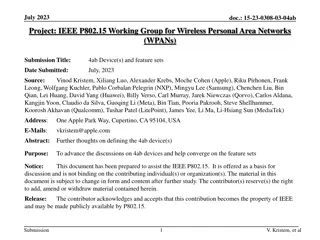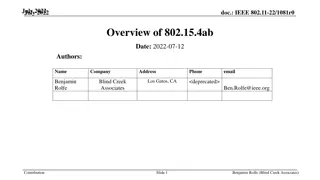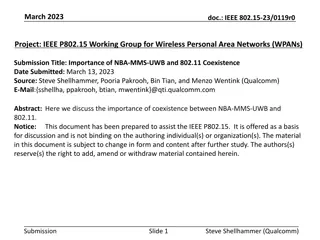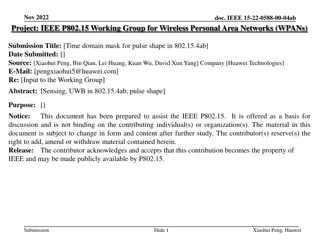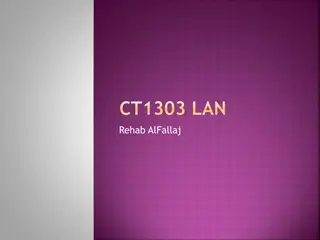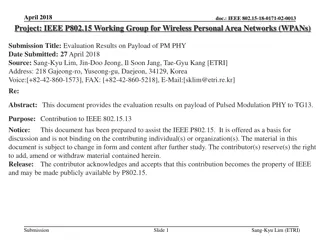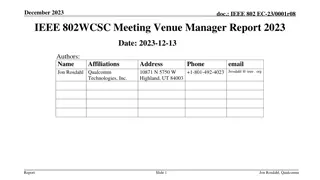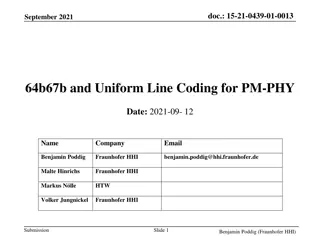Advanced Coding Techniques for Wireless Personal Area Networks - IEEE 802.15.4ab
This document discusses advanced coding techniques proposed for IEEE 802.15.4ab to enhance data communication in wireless personal area networks. The focus is on interference mitigation, coexistence improvement, link budget enhancement, additional channels, and operating frequencies for improved reliability and throughput, among other features. The text also explores the current coding standards, near Shannon capacity codes like LDPC, Turbo, and Polar codes, and their benefits in reaching near-optimal performance. Moreover, it compares IEEE 802.11n with Polar codes in terms of technology scaling.
- Wireless Personal Area Networks
- IEEE 802.15.4ab
- Advanced Coding Techniques
- Data Communication
- Interference Mitigation
Download Presentation

Please find below an Image/Link to download the presentation.
The content on the website is provided AS IS for your information and personal use only. It may not be sold, licensed, or shared on other websites without obtaining consent from the author. Download presentation by click this link. If you encounter any issues during the download, it is possible that the publisher has removed the file from their server.
E N D
Presentation Transcript
November 2021 doc.: IEEE 15-21-0506-01-04ab Project: IEEE P802.15 Working Group for Wireless Personal Area Networks (WPANs) Submission Title: Advanced Coding for Data Communications in 802.15.4ab Source: Carlos Aldana (Facebook) Address : [1 Hacker Way, Menlo Park, CA 94025] E-Mail: [caldana (at) fb.com] Re: Study Group 4ab: UWB Next Generation Abstract: [Advanced coding for 802.15.4ab] Purpose: Notice: This document has been prepared to assist the IEEE P802.15. It is offered as a basis for discussion and is not binding on the contributing individual(s) or organization(s). The material in this document is subject to change in form and content after further study. The contributor(s) reserve(s) the right to add, amend or withdraw material contained herein. Release: The contributor acknowledges and accepts that this contribution becomes the property of IEEE and may be made publicly available by P802.15. Carlos Aldana
November 2021 doc.: IEEE 15-21-0506-01-04ab Technical Guidance [1] PAR Objective Safeguards so that the high throughput data use cases will not cause significant disruption to low duty-cycle ranging use cases. Proposed Solution (how addressed) Interference mitigation techniques to support higher density and higher traffic use cases Other coexistence improvement Backward compatibility with enhanced ranging capable devices (ERDEVs). Improved link budget and/or reduced air-time advanced codes provide improved link budgets Additional channels and operating frequencies Improvements to accuracy / precision / reliability and interoperability for high-integrity ranging; Reduce complexity and power consumption; Hybrid operation with narrowband signaling to assist UWB; Enhanced native discovery and connection setup mechanisms; Sensing capabilities to support presence detection and environment mapping; Low-power low-latency streaming higher data-rate streaming allowing at least 50 Mbit/s of throughput. Support for peer-to-peer, peer-to-multi-peer, and station-to-infrastructure protocols; advanced codes will help enable this use case Infrastructure synchronization mechanisms. Carlos Aldana Slide 2
November 2021 doc.: IEEE 15-21-0506-01-04ab Background Current codes defined in 802.15.4 and 802.15.4z are based on BCC Below is BCC K=3 and K=7 performance in AWGN channel Shannon placed an upper bound on code rate for a given BW and SNR, or equivalently a minimum SNR for a given code rate and BW. Shannon limit for rate code using BPSK or QPSK (1 bit/dim) is SNR=Eb/No=0dB. For 1% PER, 3e-7 BER, the 802.15.4 code with K=3 is 9.2dB away from Shannon! Carlos Aldana Slide 3
November 2021 doc.: IEEE 15-21-0506-01-04ab Near Shannon Capacity Codes LDPC (Gallagher 1963) [2] shown to reach within 0.0045dB from the Shannon limit [3] amenable to parallelization (better latency) Turbo (Berrou 1993) [4] Polar (Arikan 2008) [5] based on idea of channel polarization Carlos Aldana Slide 4
November 2021 doc.: IEEE 15-21-0506-01-04ab IEEE 802.11n vs Polar codes [6] 90nm CMOS using standard Dennard scaling laws Area scales as s2 and operating frequency scales as 1/s, where s is the technology feature size Note: BP = belief propagation SC = successive cancellation Note: BP = belief propagation SC = successive cancellation SCL = successive cancellation list SCL = successive cancellation list Polar Decoders are not as efficient as LDPC decoders Carlos Aldana
November 2021 doc.: IEEE 15-21-0506-01-04ab Polar vs 3GPP Turbo Results Error floor associated with 3GPP LTE Turbo codes due to some combination of block size and coding rate, rate matching module leads to bad interactions between puncturing and interleaving in the turbo encoder structure . With low Hamming weights, small amounts of channel noise can induce the decoder to make completely wrong decisions, resulting in very high block error rates [7] Becomes worse at higher code rates [8] Y-axis : FER Carlos Aldana
November 2021 doc.: IEEE 15-21-0506-01-04ab Simulation Scenario AWGN channel Floating point sims Soft decisions LDPC uses layer belief propagation with offset min-sum approximations with variable number of iterations Carlos Aldana Slide 7
November 2021 doc.: IEEE 15-21-0506-01-04ab IEEE 802.11n LDPC vs BCC in AWGN PER results match closely those of [6] LDPC codes perform better for longer block lengths. Carlos Aldana Reed-Solomon results have been adjusted by 10*log10(63/55)d
November 2021 doc.: IEEE 15-21-0506-01-04ab IEEE 802.11n LDPC vs BCC in AWGN 1944 block length LDPC code provides 3.2 dB /7 dB gain over K=7 / K=3 at 0.1% PER 648 block length LDPC codes provides 2.55 dB /6.05 dB gain over K=7 / K=3 at 0.1% PER Carlos Aldana Slide 9
November 2021 doc.: IEEE 15-21-0506-01-04ab LDPC 648 on short payload K <= 324 Step 1: Encoder finds parity bits by appending zeros to K information bits K information Bits 324-K zeros 324 parity bits Step 2: Ignore 324-K zeros and send K information bits along with 324 parity bits. Note: Coding rate is now K/(K+324) Bits 324 parity bits K information Carlos Aldana Slide 10
November 2021 Performance on short payloads doc.: IEEE 15-21-0506-01-04ab Energy per bit penalty of (K+324)/(2K) SNR = Eb/No * rho, where rho is effective # bits per 2D For short payload LDPC, rho = 2*K/(K+324) For K=7 BCC with r=1/2, rho = 1 Payload size 20 bytes 21 bytes https://grouper.ieee.org/groups/802/15/calendar.html Eb/No penalty 1.8 dB 1.66 dB Payload sizes of 21 bytes or greater benefit from LDPC when compared with K=7 BCC Carlos Aldana Slide 11
November 2021 doc.: IEEE 15-21-0506-01-04ab Gains Expected from LDPC K=3 packet length 4095 bytes 4095 bytes PER BER LDPC gain (dB) 1% .1% 3e-7 at 9.2 dB 3e-8 at 9.9 dB 7.2 7.7 K=7 packet length 4095 bytes 4095 bytes PER BER LDPC gain (dB) 1% 0.1% 1e-6 at 4.8 dB 1e-7 at 5.4 dB 2.9 3.3 Larger gains expected from LDPC for larger payload sizes Carlos Aldana Slide 12
November 2021 doc.: IEEE 15-21-0506-01-04ab LDPC in IEEE 802.11n Decoder supports all code lengths 648, 1296, and 1944 It also supports code rates , 2/3, , and 5/6 12 PCMs (Parity Check Matrices) defined Carlos Aldana
November 2021 doc.: IEEE 15-21-0506-01-04ab 802.11n LDPC Performance vs Iterations 15 iterations seems like a good compromise Carlos Aldana
November 2021 doc.: IEEE 15-21-0506-01-04ab Offset min-sum approx. for 802.11n LDPC Chen showed that the offset min-sum decoding algorithm with 5 bit uniform quantization could achieve same BER as that of floating point SP and BCJR with less than 0.1 dB penalty [9] Beta values of 0.5 and 0.75 are good choices Carlos Aldana
November 2021 doc.: IEEE 15-21-0506-01-04ab LDPC in 5G NR [10] Allows for HARQ operation using incremental redundancy 2 block sizes : 8448 and 3840, 51 PCMs for each base matrix Full results can be found in [11] Parameter Base Matrix 1 Base Matrix 2 Min code rate 1/3 1/5 Max information block size 8448 3840 Carlos Aldana
November 2021 doc.: IEEE 15-21-0506-01-04ab Conclusions LDPC was successfully introduced in 802.11n [12] and 5G NR as well as other standard bodies (e.g., 802.15.3c, 802.11ad/ay, 802.16e, 802.3an, and DVB-S2) and is a mature technology that should be considered in IEEE 802.15.4ab LDPC provides substantial coding gains for long payloads and SNR gains for short payloads (e.g. 21 bytes) Implementation considerations LDPC decoder has area < 1mm2 in 90nm CMOS LDPC with 15 iterations seems like a good compromise If using offset-min-sum approximation, beta values of 0.5 and 0.75 are good choices Carlos Aldana
November 2021 doc.: IEEE 15-21-0506-01-04ab Strawpoll Are you in favor of having an optional LDPC coding scheme introduced in 802.15.4ab? Y N Abstain Carlos Aldana
November 2021 doc.: IEEE 15-21-0506-01-04ab References [1] 15-21-297-01 15.4.ab Technical Guidance Doc [2] R.G. Gallagher, Low-Density Parity-Check Codes . Cambridge, MA : MIT Press, 1963. [3] Chung, et al, On the design of low-density parity-check codes within 0.0045dB of the Shannon limit , IEEE Commun. Letters, vol. 5, no.2, pp.58-60, February 2001. [4] Berrou, et al, Near Shannon Limit Error Correcting coding and decoding : Turbo Codes , Proceedings of ICC 93 IEEE International Conference on Communications [5] Arikan, A performance comparison of polar codes and Reed-Muller codes , IEEE Communications Letters, 2008, vol. 12, issue 6. [6] Balatsoukas-Stimming, Giard, Burg, Comparison of Polar Decoders with Existing Low-Density Parity-Check and Turbo Decoders , 2017 IEEE WCNC [7] J.-F. Cheng, A. Nimbalker, Y. Blankenship, B. Classon, and T. Blankenship, Analysis of circular buffer rate matching for LTE turbo code, in Proc. IEEE 68th Vehicular Technology Conference (VTC 2008-Fall), Calgary, Canada, Sept. 2008. [8] 3GPP R1-164359 [9] Chen, Dholakia, Eleftheriou, Fossorier, Hu, Reduced-complexity decoding of LDPC codes , IEEE Trans. On Communications, vol 53, pp. 1288-1299, Aug 2005. [10] Hui, Sandberg, Blankenship, Andersson, Grosjean, Channel Coding in 5G New Radio: A Tutorial Overview and Performance Comparison with 4G LTE , in IEEE Vehicular Technology Magazine, vol. 13, Issue #4. [11] 3GPP R1-1610600 [12] IEEE 802.11 Wireless LANs WWiSE Proposal: High Throughput Extension to the 802.11 Standard, IEEE 11-04-0886-06-000n, 2005 Carlos Aldana
November 2021 doc.: IEEE 15-21-0506-01-04ab Appendix Carlos Aldana
November 2021 LDPC on short payload (truncate parity) K <= 324 Step 1: Encoder finds parity bits by appending zeros to K information bits doc.: IEEE 15-21-0506-01-04ab K information Bits 324-K zeros 324 parity bits Step 2: Ignore 324-K zeros and send K information bits along with first K parity bits. Note: Coding rate maintained at 1/2 Bits K information K parity bits Carlos Aldana Slide 21
November 2021 doc.: IEEE 15-21-0506-01-04ab Short Payloads Carlos Aldana Slide 22


